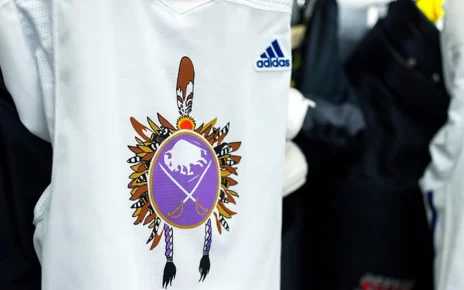November 2022 | thek.art
Photo: G. Peter Jemison’s – All Indians Don’t Live West of the Mississippi, 1987 –
Acknowledgment of the importance of Indigenous contemporary art has far to go before its potential is reached, but it is undoubtedly on the rise. Last week, during Christie’s 21st century auction category, Jaune Quick-to-See Smith’s work, I See Red: Talking to the Ancestors (1994), exploded through its estimate, and set a new record for the artist at $510,000 ($642,600 with fees). This result is a signpost on an important road.
The presence of contemporary Indigenous art in the “mainstream” art world has seen an increase over the past few years. Smith, a highly respected Native contemporary artist, has seen great success with major gallery exhibitions and notable acquisitions. Other acclaimed Native contemporary artists, such as G. Peter Jemison (Seneca), Kay WalkingStick (Cherokee), Jeffrey Gibson (Choctaw/Cherokee) and Marie Watt (Seneca) have seen similar increases in the prices and demand for their work. Although long overdue, the present success of a relatively small number of Native artists reflects and foreshadows what is happening and what will come.
Like most areas of Indigenous life and community, Indigenous contemporary art has been overlooked. As noted by Hock E Aye Vi Edgar Heap of Birds, a contemporary Native artist, “we see ourselves as bright, vibrant, clear; you think we’re gone, absent, hard to see.”[1] This has translated to Indigenous art as well.
Most people have viewed Indigenous art through a historical lens. “Traditional” Indigenous art – such as basketry, beadwork and turquoise — is what many see in their mind. Contemporary Indigenous art is not what is conjured up, despite the strong and varied group of contemporary Indigenous artists, both living and not. This view is changing, however, with a paradigm shift of how the art world, and its gate keepers, view these works.
This shift in perspective is important, as it acknowledges the bright, vibrant and current nature of Indigenous communities. In the United States, there are 574 federally recognized Native Nations, each possessing its own culture, world view and sovereignty. These Native Nations face current issues and challenges – politically, culturally and socially — from both internal and external sources. To view the Native Nations (and other Indigenous groups) as current and existing in the “now,” is important.[2] Contemporary Indigenous art enables this perspective and, because it is art, can challenge concepts and viewpoints that would likely face resistance in other contexts.
This rise is not without precedent. Similarly overlooked and ignored, the work of contemporary Black artists finally began receiving deserved general attention not too long ago. Although dominated by a few Black artists from an auction perspective (e.g., Basquiat), the market for, and attention to, Black contemporary art has risen significantly (although still far from a representational level). Currently, Just Above Midtown: Changing Spaces is on view at the Museum of Modern Art, which explores the ground-breaking art gallery opened in 1974 by Linda Goode Bryant as a place for unrecognized artists of color. Focused on Black artists, JAM also exhibited works of then unknown Native artists who are now leaders in their field. The parallels between mainstream acceptance of Black and Indigenous contemporary art are noteworthy.
Much of the recent attention to contemporary Indigenous art has come from institutions. As museums strive to diversify their often woefully homogenous collections to better reflect the reality of the world (both historically and presently), demand for Indigenous contemporary art has increased. Important and influential organizations (such as the Native-led Forge Project) have become new champions of this work. Although still underrepresented, the number of Indigenous curators and directors has also increased at important organizations. Institutions have increased their focus on Indigenous contemporary art. As evidenced by recent auction results, collectors have followed. Works are now being exhibited (and sold) at major international art fairs and within important galleries.
Contemporary Indigenous art reflects centuries of culture, meaning and community, brought to the present. It challenges pre-conceptions and stereotypes; and brings a voice to the vibrancy and contemporaneity of Indigenous life and humanity. Its ascension is both important and necessary. The point has tipped.
Dave Kimelberg (Seneca) is the founder of the K Art Gallery.





